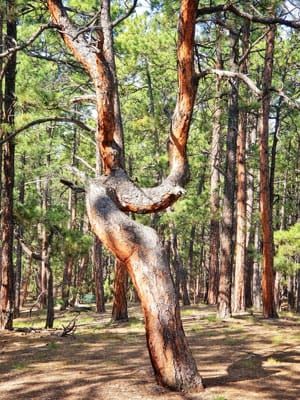Ute Indian Prayer Trees
A work of art created from nature
Article and photo by Michelle Post

I live in Monument and love the forests and mountains that surround me. I was surprised to learn that many of the places that I have hiked just miles from my home were home to Ute Indian Prayer Trees.
The definition of a Ute Indian Prayer Tree is, “a culturally modified tree.” What this means is that the Ute would take care to modify the tree by peeling its bark or bending it in places using hemp ropes created from Yucca plants or horse hair. The most common trees used by the Ute were ponderosa pines and Aspen.
According to John Wesley Anderson, author of Ute Indian Prayer Trees of the Pikes Peak Region, “All trees modified by the Ute were sacred and prayers to recognize the tree’s consent and permission in the modification were made along with gratitude to the Creator.”
In the Pikes Peak region, which includes the area around Monument, all of five types of prayers trees can be found: 1. Trailmarker Trees, 2. Medicine Trees, 3. Burial Trees, 4. Story Trees, and 5. Prophecy Trees. The trees are listed in the frequency they are found. The Prophecy Trees are the rarest; however, one does exist in Fox Run Park in Monument.
A Trailmarker Tree’s distinction is having a 30-degree bend to the trunk before it extends upward. These trees were culturally modified from the time they were a sapling by using hemp ropes attached to a stake. These trees always point toward a geographical or navigational reference point.
A Medicine Tree is distinctive by its scarred bark that has been pulled away from the tree trunk by a Ute medicine man. The bark is peeled from the top down to the bottom in one section.
A Burial Tree is distinctive and contains two 90-degree bends in the tree which point to where the Ute tribal leader is buried or a cedar tree to mark the possible site of the tribal leader.
A Story Tree or Message Tree’s distinction is that a short-story or message is carved into an Aspen tree. These carvings are called Aspen Carvings or Arborglyphs and can be compared to Petroglyphs (rock art). These arborglyphs provide specific messages to other Ute Indians, such as the location of fresh water or good camping grounds.
The Prophecy Tree is also referred to as the Providence Tree or the Intertwined Tree because it is two trees that have been culturally modified to grow together. The Prophecy Tree is the rarest of all Ute Prayer Trees. The purpose of this tree is to tell of a future event, of someone or something. These trees could have required generations of Ute to cultivate them.
The best opportunity to see the most trees in one location is Fox Run Regional Park in Monument. I highly recommend watching the YouTube video, www.youtube.com/watch?v=3LkYQbcnlkE.